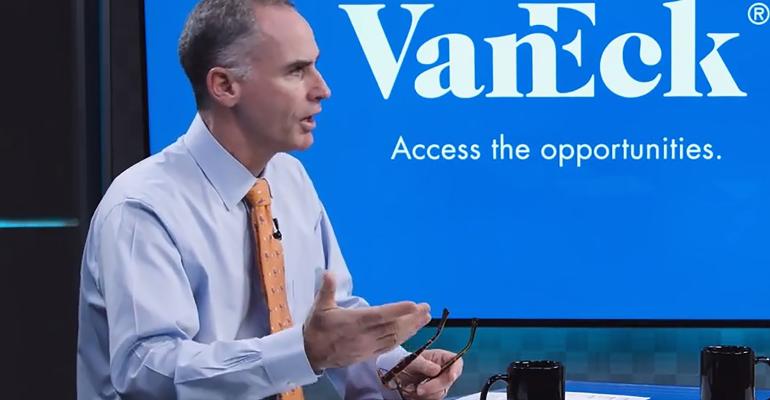One question you may have if you’re setting up a bond ETF portfolio for your clients is how many funds to include.
The answer: one to 20, depending on whether you want simple exposure to a broad index or more diversified exposure that includes areas such as high-yield and foreign bonds, says Francis Rodilosso, head of fixed-income ETF portfolio management at VanEck.
In a discussion with Wealth Management, he also explained why he likes niche ETFs--to get that more diversified exposure--and why he isn’t so keen on actively-managed bond ETFs--because they offer few advantages over the passive structure.
Wealth Management: What are the least publicized benefits of bond ETFs?
Francis Rodilosso: The cumulative effect of a low-fee diversified exposure on long-term total returns. You are compensated quite well over the long run with active or other types of bond investment. ETFs aren’t just a liquidity vehicle.
Also, there is such a broad set of tools in the fixed-income ETF space that you can either build or adjust your portfolio in an infinite number of ways through the use of bond ETTs. There’s a great set of tools out there.
WM: How should investors go about building a fixed-income ETF portfolio?
FR: There are a lot of screening tools; plenty of web sites. You have to decide what you’re using your fixed-income portfolio for. Even if you aren’t using ETFs, you have to decide what exposure you want to credit, duration, inflation-indexed bonds, floating-rate bonds and foreign currency.
You can set up your fixed-income goals and risk profile, and then there are a lot of tools to screen ETFs. You should also take the time to understand indices that show up. Look at liquidity and trading costs. Finally, there’s fees. You can go top down and find ETFs to meet your needs.
WM: What number of ETFs does an investor need for a diversified portfolio?
FR: There are some pretty broad-based ETFs. If your core fixed-income exposure is the Bloomberg Barclays Aggregate Bond Index, there are ETFs that can do that in one stop. You can also use smart beta ETFs. You could this with very few ETFs if you want to be Agg-centric.
If you want to be more diversified, if you want international, inflation-protection and floating-rate exposure, you could build around a core position. Some might not want a core position at all. So, you can set up a portfolio with anywhere from one to 20 funds.
WM: What happens to bond ETFs if interest rates resume their climb?
FR: If rates continue rising or rise more than expected, that would negatively affect all bond holders. The issue isn’t specific to ETFs.
There are two forces at work. First, the Fed is expected to raise rates twice in 2019. We may be near the end of the [rate-hike] cycle.
Also, regardless of that, the Fed has entered quantitative tightening. That’s putting risk-free paper at higher yields. This will likely mean more volatility in the market. When the ECB (European Central Bank) catches up to the Fed, that effect will be amplified.
That’s the reality the market has to prepare for. We already have seen a lot of volatility and price adjustment. For the first two-thirds of 2018 we saw higher rates. In the last part, credit spreads moved higher. Some of the better news for 2019 is that we have seen some pain in 2018. We are getting back to normal interest rates and spreads, making assets like high-yield, investment grate corporates and emerging-market debt more reasonably priced.
If the market fears recession, there would likely be concern about downgrades and default, which would raise market concerns about corporate credit. But it’s not a foregone conclusion that there will be a nasty end to the credit cycle in 2019.
WM: What do you think of actively-managed bond ETFs?
FR: You can analyze actively-managed ETFs just like mutual funds. It’s the same asset risk-taking with more manager risk than passive funds. The more passive structure is great because of pure transparency. You know what you hold every day.
I’m not sure how the ETF structure adds a lot to active management. I’m not sure it’s a bad thing. There may be some advantages on capital gains, but I know the exposure is not worth the tradeoff. If you give up transparency and potential liquidity, you are losing some of the positive aspects of the ETF structure.
WM: What’s your view of niche bond ETFs?
FR: They’re useful for portfolio tilt or as a tool to add diversification. Some of the niche ETFs get used by model portfolio managers. They can be an important provider of certain exposure to enhance risk-reward.
But niche ETFs represent smaller and less liquid options, so you have to look closely at the index construction and the history of the ETF, cost and liquidity.
WM: What are some of the interesting trends in the fixed-income ETF business?
FR: There is a continuing movement to innovate more around asset classes where ETFs have long existed. There will be enhanced aggs, smart beta, the same type of evolution in which equity ETFs are further down the road. We think there are potential market-models with ETFs of ETFs, using the liquidity of ETFs for allocation vehicles that are one-stop shopping.
And we will continue to see growth in non-core ETFs. There have been emerging-market inflows this year, even in local currencies. Corporate bond ETFs for emerging markets may gain acceptance. I think the niche trend will continue.
Francis Rodilosso will be speaking at the Inside ETFs conference on February 10-13 in Hollywood, Fla.

